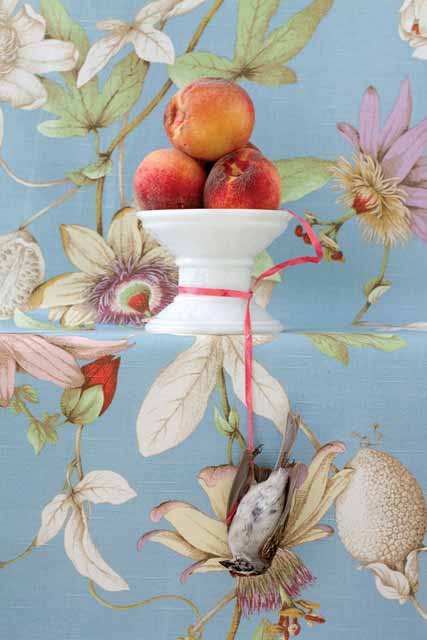The Work of Kimberly Witham
by Steve Desroches
Top Image: Domestic Arrangements, Still Life with Orange Glove (2010) by Kimberly Witham
The beauty of the natural world has bedeviled artists since prehistoric humans painted renderings of animals in the caves of Lascaux or on rocks in central Australia. How do you capture something so fleeting, so massive, and at times so tumultuous? It’s a hypnotic and intoxicating challenge, and for photographer Kimberly Witham it’s a passion. In her artistic pursuit she embraces not just the bursting life of nature, but also the decay and inevitable death. Both can be beautiful, as can be seen in her work at Gary Marotta Fine Art throughout the month of July.
Witham’s still life photography can feature brilliant flowers, fresh fruit with a bird’s nest here or an old honeycomb there. But a closer look shows the hint of a wilt of a tulip, the growing brown spot on a summer’s peach. Witham’s photographs tell the truth as it delves into the impermanence of living things and the human response to document it before it’s gone. The most striking of all the elements of her work are the dead animals within some of her still lifes. Squirrels, raccoons, deer, song birds, or a turkey; Witham surveys the road ways of rural New Jersey for road kill, the sad casualties of modern life since the advent of the automobile.
Utilizing road kill in her work has certainly drawn attention to it, but it’s the artistry and attention to detail that maintains focus on her photography. Nevertheless, turning something so gruesome as the ill-fated death of these animals sparks a fascination with death, giving it accessibility to our minds to ponder, mourn, and accept. It harkens back to the Victorian Era, a time fixated not only on death, but also the natural world when British explorers brought back trophies to fill museums and exhibition halls. Heroes of British culture, the practice of having exotic plants and animals in everyday households became fashionable as people created to scale displays in their homes.
“It’s when people became interested in natural history and taxidermy developed,” says Witham. “Things from the natural world would be in their cabinet of curiosities.”

Those cabinets, which were windows on the natural world, capture Witham’s imagination, as do the old-school dioramas in natural history museums. And to bring her vision to fruition, Witham not only works at her craft of photography, but also had to learn to preserve the deceased animals herself. She attended the American Institute of Taxidermy in Boulder Junction, Wisconsin. Both an art and a science, learning taxidermy enables her to create striking images that maintain a peaceful melancholy even when presented capturing the brightest of light and color.
Born and raised in Wakefield, Rhode Island, Witham obtained a bachelor’s degree from Duke University in art history and women’s studies, “the ultimate ‘what are you going to do with the degree?’” she adds. She went on to receive an MFA in photography at the University of Massachusetts-Dartmouth, the branch of the state university system that houses its art school and is itself a work of art, as the campus is highly regarded as a display of the best in brutalist architecture. She took her studies in art history and melded it with her love for nature, something she developed as a child growing up where the ocean meets the woods, as well as having a menagerie of animals at her childhood home. All of that mixed with her affinity for the macabre sensibilities of the Victorian era led to her bringing in road kill as material in her work. And now when she drives, without even looking, these sad endings jump right out at her as she commutes to her job teaching photography at Bucks County Community College.
“I can’t not see it now,” says Witham. “I’m driving and I’ll see the smallest creature on the side of the road. I’m also a runner, so I encounter a lot on my runs. When I moved from New York City to New Jersey, and I commuted to work in Pennsylvania, I’d be driving these country roads and there was so much road kill. I couldn’t tell if it was more than when I was younger or if it had always been that way.”
In 2016, her work garnered the attention of National Geographic, which made a short film titled Making Roadkill Into Art about her photography and taxidermy. Her photos are widely shown in the United States and abroad and largely garner positive reviews. However, in this digital and social media age, she does hear from the occasional Internet trolls who don’t read beyond headlines, and assume she killed the animals for the work itself. Those she ignores. Others feel the work exploits the animals and is disrespectful. To those she challenges them by asking them what they do when they encounter road kill. Do they just leave it on the road to become a gory red streak? Witham explains that if she encounters an animal that is too far gone or injured to be taxidermied she brings the corpse deep off the road, both out of respect and to save other animals, as scavengers often get hit by cars, too, when feeding on road kill. Not all the animals in her work are taxidermied, as laws prohibit the practice on some creatures. So when she is done, she honors the spirit of the animal as with all in her work, and gives them a proper burial.
“I try to give them a respectful end,” says Witham. “I bury them in the woods and always hold a bit of reverence for them.”
Kimberly Witham’s work is on exhibition at Gary Marotta Fine Art, 162 Commercial St., Provincetown, through July 31. For more information call 617.834.5262 or visit garymarottafineart.com.




